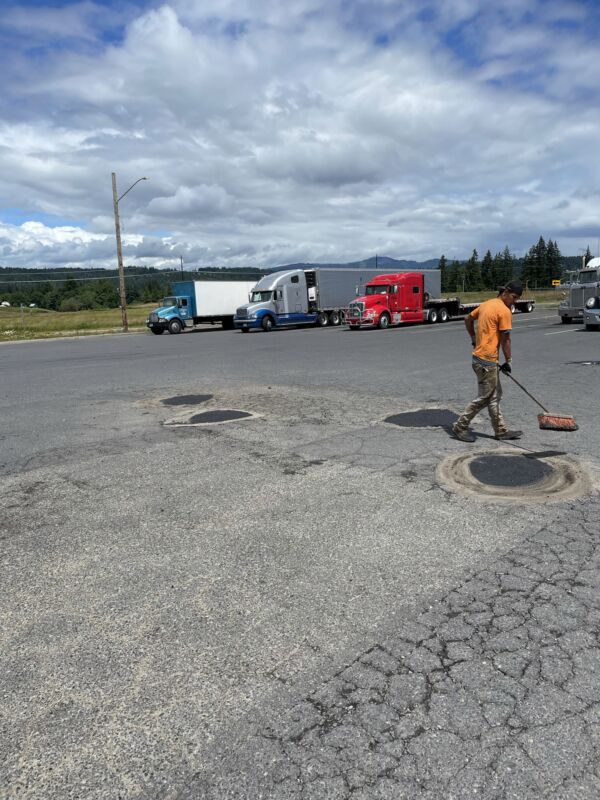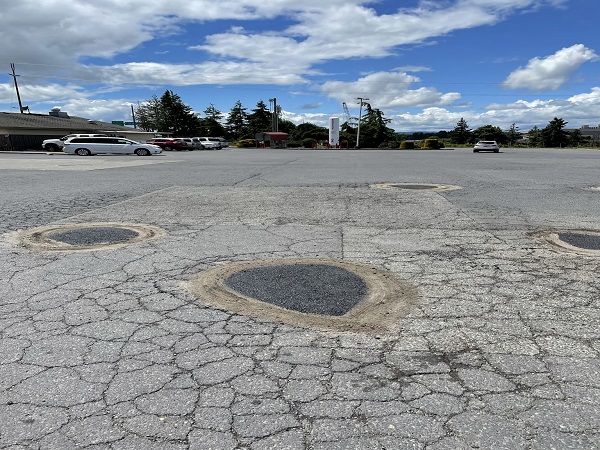Potholes
Asphalt surfaces, such as commercial driveways and parking lots, can be susceptible to damage from potholes. These unsightly blemishes are a hazard for drivers and pedestrians alike; however, they can easily be fixed with patchwork for asphalt maintenance. Pothole repair involves filling the hole with an appropriate material that will remain durable while providing an aesthetic appeal. Additionally, crack-filling services help seal off any potential weak points in your driveway or parking lot before they become more significant issues. Finally, striping your asphalt surface helps keep it looking clean and neat year-round. With these simple steps, you’ll know that potholes and patchwork for asphalt won’t disrupt operations at your business anymore.

What are Potholes?
Potholes are common pavement distress that can occur on asphalt pavements. A pothole is an indentation in asphalt caused by material displacement, often due to traffic or weather-induced events. Potholes form when water penetrates the pavement surface and weakens the underlying material. The cut material then cracks under the weight of vehicles passing over it, causing pieces to break away and create a hole in the road surface.
Causes of potholes include excessive moisture, poor drainage, extreme temperature changes (freeze/thaw cycles), aging pavement surfaces, and heavy truck tires impacting existing asphalt pavements. Poor maintenance practices, such as failing to sealcoat or repair existing cracks, can also contribute to the formation of potholes.
The effects of potholes can be severe for commercial building owners if left unrepaired for too long. In addition to creating dangerous driving conditions for motorists, they may cause damage to vehicles due to their uneven surfaces, leading to costly repairs or replacements down the line. Furthermore, large puddles often form around them during rainstorms, leading to flooding in nearby areas. This could result in property damage and liability issues should anyone get injured while trying to avoid these hazards while walking near your property’s entrance or parking lot area.
To adequately address this issue, one must identify any potential causes before beginning any repair work, such as patching up existing asphalt with hot mix asphalt (HMA) or cold mix asphalt (CMA). If larger areas are affected, more extensive patching using either HMA or CMA, depending on the material used initially, will be needed to match up correctly with surrounding areas once completed. It is essential to properly prepare a site by removing all debris from within it before laying down new materials so that they adhere propercorrectlyast longer than just filling a hole with loose gravel would otherwise. Afterward, a tack coat should be applied over both sides of each joint between patches, along with proper drainage measures taken care of beforehand. Hence, no further problems arise later on down the road after completing repairs.
Potholes are a common asphalt issue that can lead to costly repairs and hazardous driving conditions. Knowing how to repair a pothole is critical for averting additional harm.
Materials Needed for Repairing a Pothole:
Depending on your budget and time constraints, you can choose between hot mix asphalt (HMA) or cold mix asphalt (CMA). HMA requires more specialized equipment but provides better results than CMA, which is much easier to install but doesn’t last as long as HMA. Other materials needed include crushed stone aggregate base material and an appropriate binder such as bitumen emulsion or cutback asphalt, depending on your climate conditions
How to Fix a Pothole?
Before beginning the repair process, removing loose material from the asphalt and adjacent pavement surface is essential. First, loose material should be removed from the existing asphalt and surrounding pavement surface. Then, use a pick or shovel to clean out all debris from the repair area. Next, ensure that there are no truck tires or other objects that may interfere with the proper drainage of the patch area when it rains. Finally, apply a tack coat over the existing asphalt and allow it to dry before beginning repairs.
Patch Work for Asphalt Maintenance
Patchwork for asphalt maintenance is necessary to keep the pavement in top condition. Patching potholes and other pavement distresses are essential to any commercial building owner’s preventive maintenance program.
The benefits of patchwork for asphalt maintenance include extending the life of the pavement, preventing further damage, reducing safety hazards such as trip hazards, and improving overall appearance. The patchwork types depend on the existing asphalt surface that needs repair, including hot mix asphalt (HMA), cold mix asphalt (CMA), or hot applied seal coat materials.
Inspecting all patches regularly is essential to ensure the longevity of the patchwork, as some may require additional treatments such as crack filling or sealcoating down the line. A tack coat should be applied if there’s no existing binder between old and new surfaces; rolling with truck tires can also help spread material during compaction operations to ensure that everything adheres appropriately. After repairs are completed, traffic should be restricted until wholly cured.
Patchwork for asphalt maintenance is essential to keep the pavement in top condition and prevent further damage, safety, or trip hazards. Regular inspections of all patches are required to ensure their longevity, as some may require additional treatments such as crack filling or sealcoating down the line. Proper patchwork will maintain your commercial property’s parking lot surface while keeping everyone safe from risks like potholes.
Frequently asked questions
An alternative solution for potholes is combining cold patches and hot mix asphalt. Cold patch asphalt is an immediate repair measure, while hot mix asphalt can provide more permanent repairs that last longer. The two materials are combined to create a stronger bond between the existing pavement, and the new material is applied. This process requires less time than traditional methods, resulting in cost savings and improved safety due to faster completion times.
Pothole patching is repairing asphalt surfaces damaged due to wear and tear. Wearing asphalt surfaces can be attributed to various causes, such as moisture infiltration, hefty vehicular traffic, and severe weather conditions like frost. Potholes are created when pieces of the asphalt surface break away, leaving a space in the road which can cause further deterioration if not addressed quickly. Pothole patching involves filling these gaps with new material to restore structural integrity and prevent further erosion. It also helps improve traction on roads for vehicles while providing a smoother ride for pedestrians and cyclists alike.
Cold patch materials are pre-mixed and easily applied with minimal preparation, allowing for quick repair of the damaged area. To ensure proper adhesion and longevity of the repair, it’s essential to clean out any loose debris from the hole before applying the cold patch material. Once filled, tamp down or roll over the patched area to create an even surface lasting for years.
The best method for pothole patching and repair is to use a combination of hot asphalt mix and cold patch material. The hot asphalt mix is heated to 300°F, then applied over the area with a trowel or squeegee. The hard patch material can be used as an overlay on top of the hot asphalt mix, providing additional stability and durability. The two materials should be layered together in multiple layers until they reach the desired depth. This method ensures that the repairs are done correctly and last longer than other methods, such as simply filling holes with gravel or sand.

Potholes
In conclusion, potholes and patchwork for asphalt can be complex tasks. Professional services such as crack filling, sealcoating, and striping are essential to maintain the integrity of your commercial driveway or parking lot. These maintenance tasks must be performed regularly by an experienced contractor who understands the complexities involved with asphalt repair. By taking proactive measures, you will ensure that your property remains safe from any potential damage caused by potholes or large areas of deterioration due to weathering or age-related wear and tear.
If you are looking for a professional solution to your asphalt maintenance needs, look no further than Black Magic Asphalt. We specialize in a pothole and crack filling, sealcoating, striping, and patchwork services that will keep your asphalt in top condition.
To prepare for patching a pothole, remove any loose material from the existing asphalt and surrounding pavement surface before applying a tack coat. The type of materials used to repair the hole depends on budget and time constraints – hot mix asphalt (HMA) or cold mix asphalt (CMA). Once all the necessary preparations are made, you can face the challenge of fixing that pothole.
